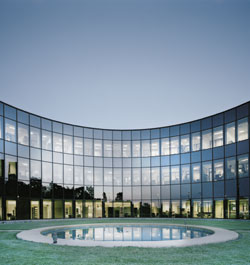 Photo: Peter Ginter |
Seiching
Maori lore says that the rising and falling of the water level in Lake Wakatipu every 51 minutes is due to the breathing of the giant sleeping beneath.
I learned this many years ago from a caption on a photograph in an Auckland art gallery, while between sessions of a conference. The caption explained that the scientific phenomenon is that of seiching (pronounced "saysh-ing"), a type of standing wave. It is most often seen in a cup of coffee when you walk with it, or at times in a bathtub when you rise quickly, and is recognizable by the nearly flat surface of the liquid as it sloshes back and forth. While in the art gallery, I remembered the first time I had seen the word was in an old International Physics Olympiad problem asking us to model the seiche in Lake Geneva.
I recalled that gallery visit while contemplating the round fountain at Fermilab's Feynman Computing Center. As the fountain's single vertical jet oscillates between a torrent and a dribble, the water in the center of the pond rises and falls in synch—a peculiar motion that is hypnotic to watch in its rare simplicity. But then I remembered one other circular seiche I had witnessed. It was driven by us, a group of young kids, jumping up and down in the center of a shallow circular swimming pool until the water would splash over the entire circumference at once.
My recall sloshed back and forth in time, renewing my lifelong fascination with seiches.
David Harris
Click here to download the pdf version of this article.






